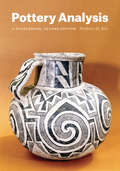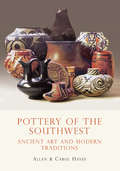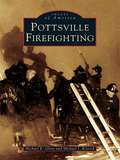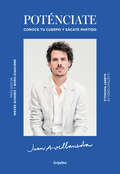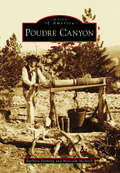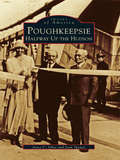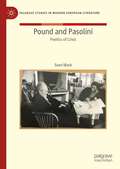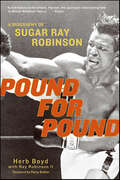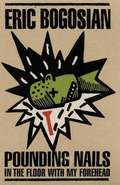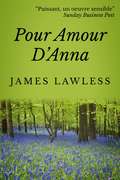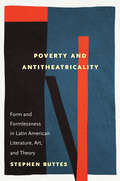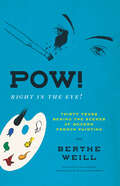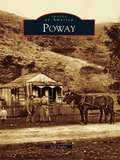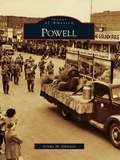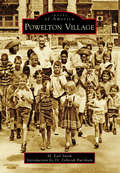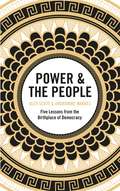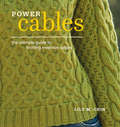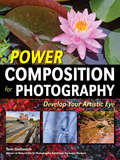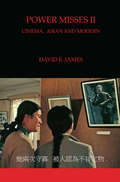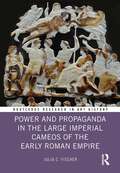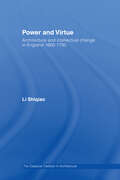- Table View
- List View
Pottery Analysis: A Sourcebook, Second Edition
by Prudence M. RiceJust as a single pot starts with a lump of clay, the study of a piece’s history must start with an understanding of its raw materials. This principle is the foundation of Pottery Analysis, the acclaimed sourcebook that has become the indispensable guide for archaeologists and anthropologists worldwide. By grounding current research in the larger history of pottery and drawing together diverse approaches to the study of pottery, it offers a rich, comprehensive view of ceramic inquiry. This new edition fully incorporates more than two decades of growth and diversification in the fields of archaeological and ethnographic study of pottery. It begins with a summary of the origins and history of pottery in different parts of the world, then examines the raw materials of pottery and their physical and chemical properties. It addresses ethnographic and ethnoarchaeological perspectives on pottery production; reviews the methods of studying pottery’s physical, mechanical, thermal, mineralogical, and chemical properties; and discusses how proper analysis of artifacts can reveal insights into their culture of origin. Intended for use in the classroom, the lab, and out in the field, this essential text offers an unparalleled basis for pottery research.
Pottery of the Southwest
by Carol HayesFor almost two thousand years, the pottery made by the Indians of America's Southwest has remained a vital art. Today, more than twenty Pueblos and tribes make pottery within the tradition, each with a distinctive style. Many of those local styles have persisted for hundreds of years. In prehistory, beautiful pieces had high trade value, and the finest contemporary pieces command prices appropriate to fine art of any type. Potters like Nampeyo, Maria Martinez and Juan Quezada achieved worldwide fame. Yet despite its history and the skill of its artists, Southwestern Indian pottery remains surprisingly easy to collect. This book introduces the art from its beginnings to the present and displays examples that describe how America's first important art form grew into one of the world's most accessible treasures.
Pottsville Firefighting (Images of America)
by Michael R. Glore Michael J. KitsockIn 1829, the Humane Hose Company and the Schuylkill Hydraulians Engine Company organized in the booming town of Pottsville, a mining center in Pennsylvania's anthracite coal region. Fire protection was urgently needed for this growing community. New fire companies such as the Good Intent, the Rough and Ready, and the Good Will formed, as well as junior fire companies, including the Rangers and the Young America. In a patriotic response to President Lincoln's call to arms, two Pottsville fire companies disbanded, committing themselves to the Union; they became members of the legendary "First Defenders" of the Civil War. The twentieth century brought new challenges of motorization, dieselization, and ever-stricter training standards. Pottsville Firefighting celebrates one hundred seventy-five years of firefighting in Pottsville.
Poténciate: Conoce tu cuerpo y sácate partido
by Juan AvellanedaJuan Avellaneda, diseñador, icono e influencer de la moda española, y considerado uno de los hombres más elegantes de nuestro país, nos ofrece sus consejos de estilo para sacar el máximo partido de nosotros mismos. «Reconozco que yo también he tenido miedo: miedo al qué dirán, a si me aceptarán... Hasta que aprendí a dejar de lado los prejuicios y aceptar mi cuerpo tal como es. Con este libro, quiero ayudarte a proyectar la mejor imagen de ti mismo, la que habla realmente de ti, gracias a todo lo que he aprendido a lo largo de mi carrera como diseñador: qué estampados o cortes te favorecen más, cuáles son los colores que realzan mejor tu personalidad o cómo puedes potenciar aún más esa parte que tanto te gusta de ti. Ya es hora de reconciliarte con tu silueta y tu aspecto, y de descubrir tu estilo personal, porque lo que más importa es que te sientas bien tal como eres.» Ahora más que nunca toca sacar lo mejor de ti.
Poudre Canyon
by Barbara Fleming Malcolm McneillCarved eons ago by the Cache la Poudre River, the Poudre Canyon, north and west of Fort Collins, Colorado, has long been a favored recreation place, for fishing, hiking, camping, and more, of area residents and tourists. The canyon has many colorful tales to tell; this book takes readers on a drive through that history, milepost by milepost, stopping at historic places and taking some side trips along the way. Beginning with trappers and mountain men, the canyon has been traveled since the early 1800s, and Native Americans roamed here for times unknown before that. Explorers came, as did seekers of gold and silver. The expanding railroads resulted in logging enterprises, and mining interests brought about better access to mining towns. Near the end of the 19th century, tourists began to enjoy the hunting and fishing of the area. In 1920, the road, which had been blocked from either direction by a place in the canyon called the Narrows, finally went through all the way, bringing resorts and tourists.
Poughkeepsie: Halfway Up the Hudson (Images of America)
by Joan Spence Joyce C. GheeFrom the colonial period, the Poughkeepsie area has been a prime location on the Hudson, midway between Albany and New York City. Accessibility, scenic beauty, and a dynamic economic and cultural environment have made both city and town of Poughkeepsie excellent communities in which to live, work, and play. Numerous Americans have left their mark here, including the Livingstons, S.F.B. Morse, the Smith Brothers (of cough drop fame), Matthew Vassar, Franklin and Eleanor Roosevelt, and Thomas Watson Sr. Poughkeepsie has also been enhanced by the contributions of its African American community and by successive waves of immigrants seeking a better life. From hosting New York's United States Constitutional Ratification Convention in 1788 to becoming the location of IBM during World War II, Poughkeepsie has continued to be the site of world-changing events.
Poultry Breeds: Chickens, Ducks, Geese, Turkeys: The Pocket Guide to 104 Essential Breeds
by Carol EkariusPoultry Breeds is a fresh field guide of feathered friends with stunning photos highlighting the beauty and unique attributes of 104 chicken, duck, goose, and turkey breeds. Each profile outlines the bird’s history, physical characteristics, and common uses, with specially noted fun facts sprinkled throughout. This pocket-size, browsable guide is easy to use, and author Carol Ekarius knows her birds: she has been writing about livestock for nearly 20 years and has raised her own for decades.
Pounce
by Seth CasteelPhotographer Seth Casteel's underwater photographs of dogs and babies have captivated an international audience. Now, Seth has found the perfect way to capture our other best friends: cats!A beautiful, funny gift book with more than 70 previously unpublished photographs, Pounce reveals adorable cats and kittens as they pounce and jump through the air, arms outstretched -- all in Casteel's signature up-close, mid-action style.
Pound and Pasolini: Poetics of Crisis (Palgrave Studies in Modern European Literature)
by Sean MarkIn October 1967, Pier Paolo Pasolini travelled to Venice to interview Ezra Pound for broadcast on national television. One a lifelong Marxist, the other a former propagandist for the Fascist regime, their encounter was billed as a clash of opposites. But what do these poets share? And what can they tell us about the poetics and politics of the twentieth century? This book reads one by way of the other, aligning their engagement with different temporalities and traditions, polities and geographies, languages and forms, evoked as utopian alternatives to the cultural and political crises of capitalist modernity. Part literary history, part comparative study, it offers a new and provocative perspective on these poets and the critical debates around them – in particular, on Pound’s Italian years and Pasolini’s use of Pound in his work. Their connection helps to understand the implications and legacies of their work today.
Pound for Pound: A Biography of Sugar Ray Robinson
by Herb Boyd Ray RobinsonHailed by critics as a long overdue portrait of Sugar Ray Robinson, a man who was as elusive out of the ring as he was magisterial in it, Pound for Pound is a lively and nuanced profile of an athlete who is arguably the best boxer the sport has ever known. So great were Robinson's skills, he was eulogized by Woody Allen, compared to Joe Louis, and praised by Muhammad Ali, who called him "the king, the master, my idol." But the same discipline that Robinson brought to the sport eluded him at home, leading him to emotionally and physically abuse his family -- particularly his wife, the gorgeous dancer Edna Mae, whose entrepreneurial skills helped Robinson build an empire to which Harlemites were inexorably drawn. Exposing Robinson's flaws as well as putting his career in the context of his life and times, renowned journalist and bestselling author Herb Boyd, with Ray Robinson II, tells for the first time the full story of a complex man and sport-altering athlete.
Pounding Nails in the Floor with My Forehead
by Eric BogosianIn his brashest solo show, performer and playwright Eric Bogosian once again aims his searing social commentary at the contemporary urban and suburban scene. "Never miss Bogosian, because the sharp-tongued, sharp-shooting Bogosian never misses."--Clive Barnes, New York Post
Pour amour d'Anna
by James Lawless Sakura A. BolteUne histoire d'un jeune anarchiste, son amante, et les problemes dans la societe qui se manifestent dans un rupture entre les amants.
Poverty and Antitheatricality: Form and Formlessness in Latin American Literature, Art, and Theory
by Stephen ButtesPoverty and Antitheatricality argues that many major analytical approaches today misunderstand the problem of poverty by emphasizing its status as an experience. These experiential models transform poverty from a specific socioeconomic status lived in a particular historical sequence into a transhistorical presence of marginality that is not only inevitable but necessary. Embedded in capitalist, socialist, and populist forms of socioeconomic organization, these models paradoxically suggest that if we want to have a world free of poverty, we must always have the poor and their experience of formlessness. Taking up the paired terms—form and formlessness—Stephen Buttes demonstrates how they sustain not only debates about poverty and its political role within modernity but also the idea of the work of art within the history of modernism. Offering critiques of critical theory alongside new readings of both canonical and little-studied Latin American authors and artists, Poverty and Antitheatricality makes a compelling case that understanding the kind of problem the work of art is opens up overlooked but essential pathways to understanding poverty and the kind of problem it is.
Pow! Right in the Eye!: Thirty Years behind the Scenes of Modern French Painting (Abakanowicz Arts and Culture Collection)
by Berthe WeillMemoir of a provocative Parisian art dealer at the heart of the 20th-century art world, available in English for the first time. Berthe Weill, a formidable Parisian dealer, was born into a Jewish family of very modest means. One of the first female gallerists in the business, she first opened the Galerie B. Weill in the heart of Paris’s art gallery district in 1901, holding innumerable exhibitions over nearly forty years. Written out of art history for decades, Weill has only recently regained the recognition she deserves. Under five feet tall and bespectacled, Weill was beloved by the artists she supported, and she rejected the exploitative business practices common among art dealers. Despite being a self-proclaimed “terrible businesswoman,” Weill kept her gallery open for four decades, defying the rising tide of antisemitism before Germany’s occupation of France. By the time of her death in 1951, Weill had promoted more than three hundred artists—including Henri Matisse, Pablo Picasso, Amedeo Modigliani, Diego Rivera, and Suzanne Valadon—many of whom were women and nearly all young and unknown when she first exhibited them. Pow! Right in the Eye! makes Weill’s provocative 1933 memoir finally available to English readers, offering rare insights into the Parisian avant-garde and a lively inside account of the development of the modern art market.
Pow! Right in the Eye!: Thirty Years behind the Scenes of Modern French Painting (Abakanowicz Arts and Culture Collection)
by Berthe WeillMemoir of a provocative Parisian art dealer at the heart of the 20th-century art world, available in English for the first time. Berthe Weill, a formidable Parisian dealer, was born into a Jewish family of very modest means. One of the first female gallerists in the business, she first opened the Galerie B. Weill in the heart of Paris’s art gallery district in 1901, holding innumerable exhibitions over nearly forty years. Written out of art history for decades, Weill has only recently regained the recognition she deserves. Under five feet tall and bespectacled, Weill was beloved by the artists she supported, and she rejected the exploitative business practices common among art dealers. Despite being a self-proclaimed “terrible businesswoman,” Weill kept her gallery open for four decades, defying the rising tide of antisemitism before Germany’s occupation of France. By the time of her death in 1951, Weill had promoted more than three hundred artists—including Henri Matisse, Pablo Picasso, Amedeo Modigliani, Diego Rivera, and Suzanne Valadon—many of whom were women and nearly all young and unknown when she first exhibited them. Pow! Right in the Eye! makes Weill’s provocative 1933 memoir finally available to English readers, offering rare insights into the Parisian avant-garde and a lively inside account of the development of the modern art market.
Poway
by Jeff FiglerThe area that would become Poway was once the roaming grounds of the Diegueno and Luiseno Indians, several hundred years before the appearance of the Spaniards. It was also a pasturing place for mission stock, a ranch area for adventurous white settlers, a potential railroad stop that never materialized, and today is a diversified, thriving "city in the country" located within San Diego County. The story of Poway is one of many cultures, of many changes, and of many triumphs. Today it is a very desirable city in which to live, raise families, and send children to school; it is home to about 57,000 residents glad to have found the pleasures of living in Poway.
Powell
by Jeremy M. JohnstonBy 1909, the completion of the Garland Canal brought water to the arid lands in the central Bighorn Basin, transforming the high plains desert into irrigated farmland. Homesteaders and businessmen poured into the region and established the town of Powell, named after famed government explorer John Wesley Powell. Residents of Powell worked through the years to overcome a variety of obstacles and establish a vibrant and lasting community that would continue to bloom in the arid landscape.
Powelton Village (Images of America)
by Dr Deborah Burnham M. Earl SmithFrom its humble beginnings as a strip of wilderness just west of William Penn's "greene country towne," Powelton Village has seen a rise in both prestige and activism since its inception in the late 17th century. An aristocratic estate at its founding, Powelton has found itself in a state of constant evolution, from the summer retreat of George Washington to the home of Pennsylvania's agricultural fair and from the playground of the elite to a hotbed of activism. In spite of, or because of, its mixed history, Powelton Village is unique among Philadelphia neighborhoods, both in its eclectic diversity and in its historic roots to the founding of the nation. Today, Powelton serves as a home to academics and their students, to the urban poor of Philadelphia, and to the elites of the University of Pennsylvania and Drexel University.
Power & the People: Five Lessons from the Birthplace of Democracy
by Alev Scott Andronike MakresDEMOCRACY WAS BORN IN ATHENS. FROM ITS FOUNDING MYTHS TO ITS GOLDEN AGE AND ITS CHAOTIC DOWNFALL, IT'S RICH WITH LESSONS FOR OUR OWN TIMES.'Timely and fascinating' Robin Lane FoxWhy did vital civic engagement and fair debate descend into populism and paralysis? Can we compare the demagogue Cleon to President Trump, the Athenian Empire to modern America, or the stubborn island of Melos to Brexit Britain? How did a second referendum save the Athenians from a bloodthirsty decision? Who were the last defenders of democracy in the changing, globalised world of the 4th Century BC, and how do we unconsciously echo them today?With verve and acuity, the heroics and the critics of Athenian democracy are brought to bear on today's politics, revealing in all its glories and its flaws the system that still survives to execute the power of the people.
Power Cables: The Ultimate Guide to Knitting Inventive Cables
by Lily ChinFrom simple to sculptural, the original cable patterns explored in this must-have resource create a foundation of techniques for designing signature knitwear. Basic twisted stitches, complex interpretations of cables, reversible cables, adding texture and color, turning stitches around, constructing cables with I-cord, and wrapping stitches to create the illusion of cables are some of the integrated techniques detailed in this guide. Contained within are more than 15 original cable patterns for pullovers, jackets, bags, socks, and accessories. Also included is information on a new charting system for predicting cable behavior as well as tips on cabling without a cable needle, choosing the best yarns for specific cable effects, and designing original cable patterns.
Power Composition for Photography
by Tom GallovichIn this book, Tom Gallovich shows readers how to use their camera’s exposure controls (aperture, shutter speed, ISO) to establish the focal point of the image and create the overall mood of the shot and choose a particular lens or focal-length setting to massage the way elements in the original scene will appear within the frame. Next, he presents chapters on using shape, color, lines, and arrangement to strengthen the intended visual message. Readers will learn how to best place their primary subject (and in some cases secondary subject) for maximum impact and will discover artistic strategies that reinforce that decision through careful use of color, tone, highlight and shadow, leading lines, curved shapes, and relative size-qualities that will contribute to the overall mood in the image. Copious illustrations emphasize the impact that putting these concepts into play will have on your images-and these are often coupled with images that show how ineffective images are when those important compositional needs are not attended to.
Power Composition for Photography
by Tom GallovichIn this book, Tom Gallovich shows readers how to use their camera's exposure controls (aperture, shutter speed, ISO) to establish the focal point of the image and create the overall mood of the shot and choose a particular lens or focal-length setting to massage the way elements in the original scene will appear within the frame. Next, he presents chapters on using shape, color, lines, and arrangement to strengthen the intended visual message. Readers will learn how to best place their primary subject (and in some cases secondary subject) for maximum impact and will discover artistic strategies that reinforce that decision through careful use of color, tone, highlight and shadow, leading lines, curved shapes, and relative size-qualities that will contribute to the overall mood in the image. Copious illustrations emphasize the impact that putting these concepts into play will have on your images-and these are often coupled with images that show how ineffective images are when those important compositional needs are not attended to.
Power Misses II: Cinema, Asian and Modern
by David E. JamesLike David James' earlier collection of essays, Power Misses: Essays Across (Un)Popular Culture (1996), the present volume, Power Misses II: Cinema, Asian and Modern is concerned with popular cultural activity that propose alternatives and opposition to capitalist media. Now with a wider frame of reference, it moves globally from west to east, beginning with films made during the Korean Democracy Movement, and then turning to socialist realism in China and Taiwan, and to Asian American film and poetry in Los Angeles. Several other avant-garde film movements in L.A. created communities resistant to the culture industries centered there, as did elements in the classic New York avant-garde, here instanced in the work of Ken Jacobs and Andy Warhol. The final chapter concerns little-known films about communal agriculture in the Nottinghamshire village of Laxton, the only one where the medieval open-field system never suffered enclosure. This survival of the commons anticipated resistance to the extreme and catastrophic forms of privatization, monetization, and theft of the public commonweal in the advanced form of capitalism we know as neoliberalism.
Power and Propaganda in the Large Imperial Cameos of the Early Roman Empire (Routledge Research in Art History)
by Julia C. FischerThis study examines the five extant large Imperial cameos of the Early Roman Empire as a coherent whole, revealing that these gemstones were a referential group with complex interrelationships.Power and Propaganda in the Large Imperial Cameos of the Early Roman Empire offers a feminist theory that explains why large Imperial cameos were in dialogue and why the medium appears with Octavian and disappears by the Flavian dynasty: female Imperial family members commissioned them to advance their husbands and sons. This volume is an introduction to large Imperial cameos and reveals their importance for the understanding of Roman art and iconography and the implications of its theorized Imperial female patronage.The book will be of interest to scholars working in art history, classics, and archaeology.
Power and Virtue: Architecture and Intellectual Change in England 1660�1730 (The Classical Tradition in Architecture)
by Shiqiao LiThis is the first full-length study on the connections between English architecture and intellectual change between 1660 and 1730. As new ideas developed in post-Restoration England across the realms of politics, culture, academia and morality, so too did architectural expression of these ideas. Power and Virtue articulately engages English architecture with notions of power and virtue in terms of empirical knowledge on the one hand and humanism and virtuosi on the other.Aimed at an academic readership in history and theory of architecture and the history of English architecture, this unique study will also interest those studying the ideas of material culture.
